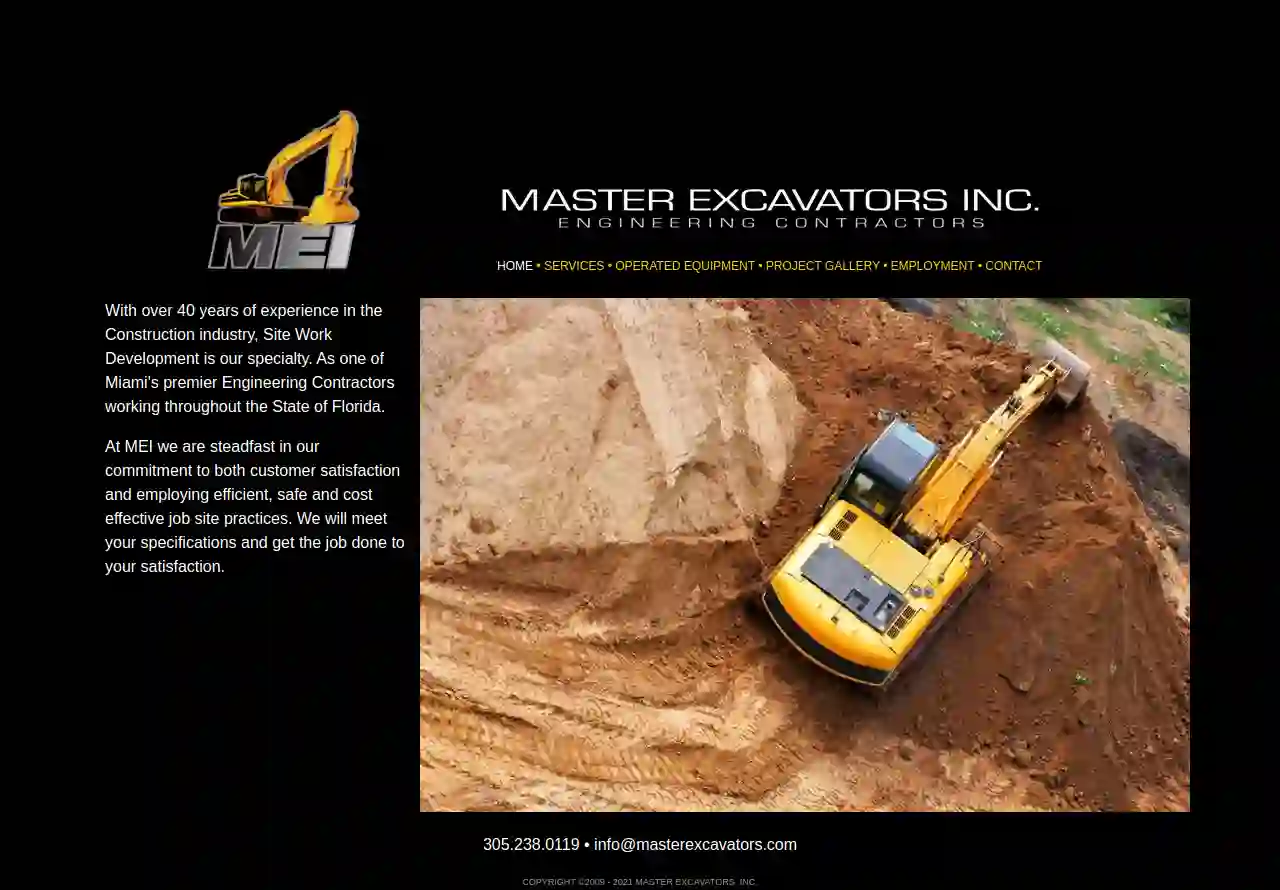Excavation Contractors Miami
Top Excavation Contractors in Miami
Receive 3 FREE Excavation Services quotes for your project today! Compare profiles, reviews, accreditations, portfolio, etc... and choose the best service.

Bloodgood Construction
51 reviews682 NW 34th st, Miami, 33127, USBloodgood Construction We are a Florida State Certified Building Contractor. Contact us regarding your construction project. Services Offered Residential Construction Commercial Building Remodeling of existing buildings Custom fabrication / Cabinetry / Millwork Construction Consulting Engineering Architectural design Project management About Us Grant Bloodgood, the founder, studied design at Parsons in New York and holds a Masters of Fine Arts Degree in Multimedia with a concentration in Sculpture. With over 30 years of experience, he brings his artistic vision and skilled craftsmanship to every project, transforming your home or dream into a reality. Our Approach We design custom architectural solutions, providing engineering and architectural design services within our team. We understand your design needs and offer solutions that streamline the process from conceptual renderings, zoning surveys, marketing analysis, and complete design plans. Quality Construction We have a local team of skilled craftsmen with over thirty years of experience in residential and commercial construction. We are committed to building the highest quality spaces, exceeding your expectations and bringing your dreams to life. Heritage Builder Our dedication to craftsmanship is a tradition rooted in taking pride in our work. We build "heritage" houses, homes designed to last over a century. At Bloodgood Construction, this European tradition continues. Craftmanship Regardless of style, craftsmanship is timeless. We apply the same high standards and quality to all our projects, whether it's a residential home or a commercial space. The Restaurant We specialize in custom millwork and commercial construction. Our commitment to quality and standards remains unwavering across all our projects.
- Services
- Why Us?
Get Quote
YP Septic Excavations
1930 NW 143rd Street, USAbout YP Septic Excavations LLC YP Septic Excavations LLC is a family-owned and operated construction company specializing in the installation of high-quality septic systems, lift stations, and French drainage. Founded in 2021 by Yosbel Paez, YP Septic Excavations LLC takes pride in its experienced and licensed team who are dedicated to providing meticulous services at the earliest convenience of customers, while also caring for the environment and leaving a clean, leveled site after construction. Our Expertise 500+ Successful Projects Completed 310 Average amount of days to complete the job after receiving the deposit 2021 Established Years of Experience Yosbel Paez CEO, YP Septic Excavations LLC Our Collection We Offer a Range of Services to Meet Your Needs At YP Septic Excavations LLC, we are committed to providing personalized solutions that address your unique requirements. Our dedicated team ensures that every aspect of your project is handled with the utmost care and expertise. We offer Free Consultations and Estimates. For consultations that require coming to the site and determining the cause of the problem, a fee of 150$ will be charged. If a customer decides to do the repair with us, a 150$ fee will be deducted from the price of the project.
- Services
- Why Us?
- Our Team
- Gallery
Get Quote
Bobcat Services / Bobcat service (The Bobcat Master)
516 reviews123 Main Street, [CITY], 12345, USAbout The Bobcat Master The Bobcat Master is a family-owned and operated business serving the [CITY] area for over 15 years. We specialize in providing high-quality bobcat services for a wide range of projects, from landscaping and excavation to demolition and snow removal. Our team of experienced operators is dedicated to providing exceptional customer service and delivering results that exceed your expectations. We understand that your time is valuable, so we strive to complete all projects efficiently and on time. We also offer competitive pricing and free estimates on all services. Whether you're a homeowner, contractor, or business owner, The Bobcat Master is your one-stop shop for all your bobcat needs.
- Services
- Why Us?
- Testimonials
Get Quote
One Stop Pavers
4.821 reviews3350 SW 148 Ave., Suite 110, Miramar, 33027, USWE PAVE SOUTH FLORIDA SINCE 2011 YOUR ONE STOP PAVERS FOR RESIDENTIAL AND COMMERCIAL PAVING: Driveway Pavers Enhance your front yard while increasing your property value. Courtyard Pavers Update your entertaining areas while Increasing your property value. Sidewalk Pavers Beautify your walk ways while Increasing your property value. Pool Deck Pavers Remodel your pool with anti-slip pool safety and pool bull nose coping updates which increase your property equity. Pool Bull Nose Coping Remodel your pool with a rounded edge finish that will enhance its safety and look. Paver Installation and repairs Our paver installations come with a one year warranty. For paver repairs we require a minimum 200 SF. YOUR ONE STOP SHOP FOR ALL TYPES OF PAVER MATERIALS: Clay Brick Pavers Clay Brick Pavers can be used indoors or outdoors, almost everywhere, including floors, pools, patios, shower rooms, countertops and backsplashes.Clay Brick Pavers are an economical alternative that is durable and versatile. Natural Stone Pavers TRAVERTINEIdeal for both interior/exterior, easy to clean. Polished finish provides a smoother, glossier look. Very colorful options, and retain their brightness and natural beauty for a long time.MARBLEA luxurious alternative fo some tastes, ideal for specific personality and styles. Natural glow, offers a slight separation between tiles.TILEVery easy to clean and maintain. Ideal for kitchen and bathroom floors for moisture protection. Tiles withstand friction and rapid temperature changes. Concrete Brick Pavers Concrete brick pavers last a long time and are very strong.They can withstand the heavy weight of automobiles and trucks.Durability makes concrete brick pavers a high demand material for parking areas.
- Services
- Why Us?
- Testimonials
- Gallery
Get Quote- A&
A&K Backhoe Service
51 reviews123 Main Street, CITY, 55555, USAbout AK Backhoe Service AK Backhoe Service is a locally owned and operated business dedicated to providing high-quality backhoe services to the [CITY] area. We have a team of experienced and skilled operators who are committed to delivering exceptional results on every project. Whether you need excavation, trenching, site preparation, or any other backhoe service, we have the expertise and equipment to get the job done right. We pride ourselves on our commitment to customer satisfaction. We work closely with our clients to understand their needs and ensure that their projects are completed on time and within budget. We also prioritize safety and environmental responsibility in all our operations. Contact us today for a free consultation and let us help you with your next project.
- Services
- Why Us?
- Gallery
Get Quote 
Master Excavators Inc
4.37 reviewsMiami, US- Services
- Why Us?
Get Quote
Restore Construction Group, Inc.
4.123 reviewsHallandale Beach, USENHANCING THE VALUE OF YOUR PROPERTY Restore Construction Group, Inc. enhances condominiums, hotels and commercial properties in the South Florida market to increase their property values. RESULT DRIVEN COMPANY LEADING THE RESTORATION INDUSTRY SINCE 2006 We are leaders in the condominium, hospitality and commercial high-rise repair, painting and waterproofing industry. ORCHESTRATING THE NEEDS OF OUR CUSTOMERS, THE KNOWLEDGE OF THE ENGINEERS AND THE EXECUTION OF OUR PROFICIENCY Empowering collaboration among all parties involved to maximize the time and success of all our projects. BEYOND BASIC SAFETY STANDARDS TO AN EMPOWERING HEALTH & SAFETY CULTURE Continuously improving safety & health habits for a better workforce and quality performance. COMMITMENT TO QUALITY AND TIMELY JOB COMPLETION Seasoned and dependable staff dedicated to deliver projects on time. Who We Are Since 2006 Restore Construction Group, Inc. has been enhancing condominiums, hotels and commercial properties in the South Florida market as well as other parts of the Country to increase their property values. We are a leader in the condominium, hospitality and commercial high-rise repair, painting and waterproofing industry. Our projects range from $1K to projects well over $20M. At Restore Construction Group, we orchestrate the need of the customer, the knowledge of the engineer and the execution of our proficiency. We are strategically located in Hallandale Beach, Florida. This location allows us the opportunity to service the tri-county area and be at any project within this area in less than an hour.
- Services
- Why Us?
- Testimonials
- Gallery
Get Quote
Construgama 77 LLC
51 reviews1629 Northwest 79th Avenue, Doral, FL, 1629 Northwest 79th Avenue Doral, 33126, USCONSTRUCT THE FUTURE WITH US! Construgama 77 LLC, an established Shell Construction Company in South Florida, provides clients with unmatched quality, lean work and committed to the highest standards. VIEW OUR WORK GET A QUOTE 10+ YEARS OF EXPERIENCE With over 10 years of experience in the construction industry, our company has the expertise and knowledge to deliver high-quality projects on time and on budget. Trust us to bring your construction vision to life. LEAN WORK APPROACH Our lean work approach means we optimize resources and minimize waste, resulting in efficient and cost-effective construction projects for our clients. Trust us to deliver quality work that maximizes value for your investment. TRUSTED BY OVER 500 COMPANIES IN FLORIDA With over 500 companies in Florida trusting us with their construction projects, you can be confident that we have the experience and expertise to deliver exceptional results. Trust us to bring your construction vision to life. NO PROJECT TOO BIG OR TOO SMALL At our construction company, we believe that no project is too big or too small for us to handle. Whether you are looking to build a large commercial complex or a small residential home, we have the skills and expertise to deliver outstanding results. Our team is equipped with the latest tools and technology to ensure that even the most complex projects are completed on time and within budget. We take pride in our ability to handle projects of all sizes, and we believe that our commitment to excellence is what sets us apart from other construction companies. We take the time to understand your unique needs and work with you to develop a customized plan that meets your budget and timeline. Whether you need help with site preparation, design, or construction, we have the skills and expertise to get the job done right.
- Services
- Why Us?
- Testimonials
- Gallery
Get Quote
ASAP GROUP
4.36 reviews3600 Red Road, Suite 406, Miramar, 33025, USWHO WE ARE ASAP Group is a leading provider of engineering, design, and construction services for a wide range of projects, including sheet piling, specialty foundations, and value-engineering. We are committed to providing our clients with the highest quality services and solutions, delivered on time and within budget. OUR STORY ASAP Group was founded on the principle of providing our clients with the highest quality services and solutions, delivered on time and within budget. We have a proven track record of success in a wide range of projects, and we are committed to exceeding our clients' expectations. OUR TEAM Our team of experienced engineers, designers, and construction professionals is dedicated to providing our clients with the best possible service. We are committed to safety, quality, and innovation, and we are always looking for ways to improve our services. OUR BUSINESS UNITS ASAP Group has a number of business units that specialize in different areas of engineering, design, and construction. This allows us to provide our clients with a comprehensive range of services, tailored to their specific needs. OUR PHILOSOPHY Our philosophy is simple: to provide our clients with the highest quality services and solutions, delivered on time and within budget. We are committed to safety, quality, and innovation, and we are always looking for ways to improve our services. WHERE WE OPERATE ASAP Group operates throughout the United States, providing our clients with the highest quality services and solutions, delivered on time and within budget. WHAT WE DO ASAP Group provides a wide range of engineering, design, and construction services, including: Sheet piling Specialty foundations Value-engineering HOW WE DO IT ASAP Group is committed to providing our clients with the highest quality services and solutions, delivered on time and within budget. We achieve this by: Using the latest technology and techniques Employing a team of experienced professionals Maintaining a strong commitment to safety and quality
- Services
- Why Us?
- Testimonials
- Gallery
Get Quote
The EZ Street Company
113611 S. Dixie Hwy, Suite 430, Miami, 33176, USREDEFINING THE STANDARD IN ASPHALT TECHNOLOGY Pioneering Change in Global Infrastructure Nearly three decades ago, EZ STREET emerged as a revolutionary alternative to hot mix asphalt. Today, still founder-driven, we’re just getting started. At the heart of our tech-savvy, lean approach is a team of leaders, partnering with the finest in the industry. With EZ STREET, we’re not just filling potholes; we’re reshaping the global landscape of infrastructure. Each application is a step towards a more resilient and efficient world. Our solutions don’t merely patch; they revolutionize, turning everyday repairs into opportunities for lasting improvement. It’s about creating a seamless, enduring connection in our streets and communities, one pothole at a time. ORDER NOW Throw it in, compact it, walk away, never worry EZ STREET transcends boundaries, serving everyone from private builders to sovereign governments, to DIY enthusiasts with unrivaled value and efficiency. For over 29 years, we’ve been redefining asphalt technology, driving innovation, and leading global infrastructure advancement. Our mission is simple yet ambitious: to offer uncompromising performance and supreme convenience.
- Services
- Why Us?
- Testimonials
- Gallery
Get Quote
Over 3,943+ Excavation Contractors in our network
Our excavation companies operate in Miami & surrounding areas!
ExcavationHQ has curated and vetted Top Excavation Pros in and around Miami. Find the most reliable pro today.
Frequently Asked Questions About Excavation Contractors
- New Construction: Laying foundations, basements, or underground utilities for new buildings.
- Home Additions: Creating space for new rooms, basements, or extensions.
- Landscaping: Leveling ground, creating slopes, installing retaining walls, or digging for ponds or pools.
- Drainage Improvement: Installing French drains, drainage ditches, or swales to manage water runoff.
- Utility Installation or Repair: Laying new water, sewer, gas, or electrical lines, or repairing existing ones.
- Demolition: Clearing debris and preparing the site after demolishing a structure.
- Clear the Area: Remove any obstacles, including vehicles, outdoor furniture, landscaping features, or structures, from the excavation zone and surrounding area.
- Mark Existing Features: Identify and mark underground utilities, septic tanks, sprinkler systems, or other buried elements you want to protect.
- Protect Landscaping: Use tarps or fencing to shield trees, shrubs, gardens, or other landscaping elements from damage.
- Provide Access: Ensure the excavation contractor has clear access to the work area, including gates wide enough for equipment.
- Discuss Logistics: Coordinate with the contractor regarding parking arrangements, material delivery, and any special instructions or concerns you might have.
- Sloped Property: Your property has a significant slope, making it prone to soil erosion or landslides.
- Creating Usable Space: You want to level off a sloped area to create a flat surface for patios, gardens, or other outdoor spaces.
- Preventing Damage: Erosion is threatening existing structures, driveways, or walkways.
- Landscaping Features: You're incorporating tiered gardens, raised beds, or other landscaping elements requiring soil retention.
How do I know if I need excavation for my project?
How do I prepare my property for excavation?
What is the difference between topsoil and subsoil?
Topsoil: The uppermost layer, typically rich in organic matter, nutrients, and microorganisms. It's essential for plant growth and is often darker in color.
Subsoil: The layer beneath the topsoil, containing less organic matter and generally denser. It provides support for roots but is less fertile than topsoil.
During excavation, topsoil is often removed and preserved separately for later use in landscaping, while subsoil is typically used for backfilling or other less demanding applications.
How do I know if I need a retaining wall?
How do I know if I need excavation for my project?
- New Construction: Laying foundations, basements, or underground utilities for new buildings.
- Home Additions: Creating space for new rooms, basements, or extensions.
- Landscaping: Leveling ground, creating slopes, installing retaining walls, or digging for ponds or pools.
- Drainage Improvement: Installing French drains, drainage ditches, or swales to manage water runoff.
- Utility Installation or Repair: Laying new water, sewer, gas, or electrical lines, or repairing existing ones.
- Demolition: Clearing debris and preparing the site after demolishing a structure.
How do I prepare my property for excavation?
- Clear the Area: Remove any obstacles, including vehicles, outdoor furniture, landscaping features, or structures, from the excavation zone and surrounding area.
- Mark Existing Features: Identify and mark underground utilities, septic tanks, sprinkler systems, or other buried elements you want to protect.
- Protect Landscaping: Use tarps or fencing to shield trees, shrubs, gardens, or other landscaping elements from damage.
- Provide Access: Ensure the excavation contractor has clear access to the work area, including gates wide enough for equipment.
- Discuss Logistics: Coordinate with the contractor regarding parking arrangements, material delivery, and any special instructions or concerns you might have.
What is the difference between topsoil and subsoil?
Topsoil: The uppermost layer, typically rich in organic matter, nutrients, and microorganisms. It's essential for plant growth and is often darker in color.
Subsoil: The layer beneath the topsoil, containing less organic matter and generally denser. It provides support for roots but is less fertile than topsoil.
During excavation, topsoil is often removed and preserved separately for later use in landscaping, while subsoil is typically used for backfilling or other less demanding applications.
How do I know if I need a retaining wall?
- Sloped Property: Your property has a significant slope, making it prone to soil erosion or landslides.
- Creating Usable Space: You want to level off a sloped area to create a flat surface for patios, gardens, or other outdoor spaces.
- Preventing Damage: Erosion is threatening existing structures, driveways, or walkways.
- Landscaping Features: You're incorporating tiered gardens, raised beds, or other landscaping elements requiring soil retention.